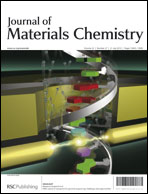We report the preparation and characterization of metal–carbon nanocomposites (NiRuC, FeRuC, and CoRuC) with bimetallic Ni–Ru, Fe–Ru, and Co–Ru nanoparticles incorporated into the pore walls of ordered mesoporous carbon, which were synthesized via a template strategy. Pt nanoparticles were deposited on the nanocomposites separately, which is different from the traditional alloying method. Nitrogen adsorption, X-ray diffraction, X-ray photoelectron spectroscopy, transmission electron microscopy, and thermogravimetric analysis techniques were used to characterize the materials. It was found that bimetallic nanoparticles (Ni–Ru, Fe–Ru, and Ru–Co) are homogenously dispersed in the carbon matrix and Pt nanoparticles with a size of less than 5 nm are widely distributed within the nanocomposites. The Pt/CoRuC catalyst shows better catalytic activity for the methanol oxidation reaction (MOR) than Pt on FeRuC or NiRuC, and its performance is also closer to that of the commercial PtRu catalyst with a slightly higher metal loading. A kinetic-based impedance model was used to simulate the electrochemical properties of the catalysts and matches well with the MOR performances of the catalysts. The promotional effect of the bimetallic/carbon nanocomposites on the catalytic activity of Pt was evidenced, and more importantly, the ligand effect was demonstrated by our results to be the major factor in the enhancement. Our investigation not only provides further insight into the roles of Fe, Ni and Co in MOR, but also assists in the design and synthesis of the new types of nanostructured electrocatalyst supports.


 Please wait while we load your content...
Please wait while we load your content...